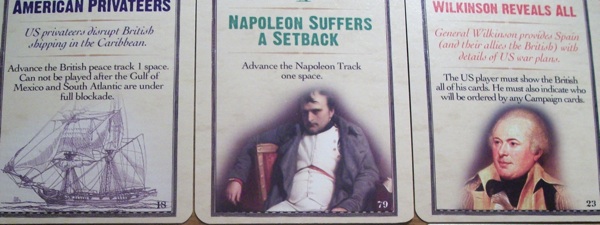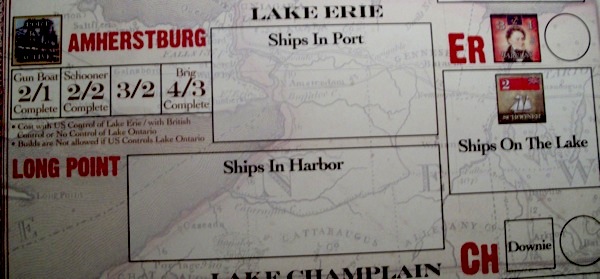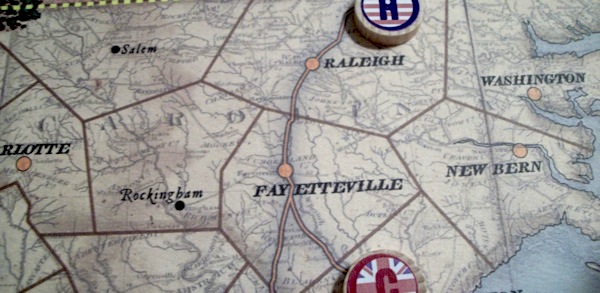Amateurs to Arms! – Boardgame Review
 Amateurs to Arms! Boardgame. Publisher: Clash Of Arms Games. Designers: Jerry Shiles, Kevin McPartland. $98.00
Amateurs to Arms! Boardgame. Publisher: Clash Of Arms Games. Designers: Jerry Shiles, Kevin McPartland. $98.00
Passed Inspection: Great strategic simulation of early 19th century warfare, wealth of historical research went into the design, balanced mix of card play and battles
Failed Basic: high price considering the components; lengthy playing time
Two hundred years ago, the British had yet to fully live up to the treaty terms that had ended the American Revolution three decades earlier, and the United States still wanted Canada to be part of the Union. With Napoleon marching around Europe like he owned the place—which he pretty much did—the United States decided to take advantage of Britain’s continental distractions and declared war on Great Britain. So began one of the more confusing wars of history, the War Of 1812, which happily is the subject of a not-at-all-confusing wargame produced by Clash Of Arms.
{default}Amateurs To Arms! (the title is taken from an excellent book by Colonel John Elting on the War Of 1812) is a fantastic game design, a card-play game that is also a solid simulation of the strategic military, economic, and political factors that shaped this multisided war. Open up the handsome box and you’ll find the rulebook, designers’ notes book, 352 full-color counters on two sheets, 30 wooden circular markers, six assorted player aid cards, two 10-sided dice, and a nice 22×34-inch map based on an 1812 map of North America. The map ingeniously contains nearly all of the various charts and tracks needed for play. You also get 150 full-color Action Cards around which the game play revolves.
The units are a colorful mix of military types: line (regular army) units, militia, a few cavalry and artillery, and pro-British Indians. Leaders are important in this game and both sides have over 30 commanders available; basic rules cover promotions and replacements. A wealth of game markers are placed on the map (burned cities, forts, roads, etc.) and on the various tracks to regulate game events (Peace Track, Napoleon Ascendant Track, Secretary Of War space, etc.). Land and naval units are usually not placed on the map but on an Expeditions card, and round, wooden Expedition markers are moved across the map.

US military units and leaders
Naval vessels run from gunboats and schooners up to ships of the line. Ships are built and moved only on the Great Lakes—the Royal Navy is so powerful that its control of the Atlantic is simply assumed in the game design. His Majesty’s ships can blockade sea-lanes, conduct coastal raids and, once Napoleon has been defeated, ferry one (and only one) BIG invasion force.
The large deck of 150 cards covers events minor (such as A Glancing Blow—both sides have their battle losses increased by two) to major (British Government Falls). Featuring a wonderful collection of period-specific illustrations, the cards are a veritable history lesson of the War Of 1812, with cards such as the innovative commodore Joshua Barney or US Government Goes Bankrupt. (It already happened?) The designers’ notes booklet has a card-by-card description of who or what that card represents, which makes this an excellent tool for learning more about this fascinating time in our history.
Action Cards come in four different colors; green are Napoleonic cards and must be played, red cards are helpful to the British, blue cards are helpful to the Americans, and the black cards are events that can affect either side. Some cards are marked Reaction and are played out of sequence at a specific point in the game, usually relating to combat (so Squall can be played to immediately end a naval battle during any round of combat). Action Cards contain both an event and an Operations Points number.

Action cards are at the center of this system; 150 cards with over 100 events represented.
To start the game, place the Turn marker in the "May-June" space and the Year marker in the "1812" space. There are a few units and leaders already in play, indicated on the Expedition charts; set those units on the chart and place the Expedition markers in the spaces indicated. Each player is dealt four Action Cards. The British go first in the first turn, then the Americans go first every turn afterwards until Napoleon is defeated, at which point the British regain initiative.
The first player in the turn chooses to play a card from his hand, save a card by placing it face-down in front of him, or pass. Cards marked Must Be Played cannot be saved; they must be played out of your hand at some point in the turn. Reaction cards that are saved can be played this turn. Otherwise, saved cards are simply placed back into your hand at the end of the turn. Players alternate playing or saving cards until everyone’s hand is emptied or one player passes (does not play or save) twice. At that point the turn is over; both players discard any cards still in their hands, pick up their saved cards, and then move the turn marker forward and draw the number of Action Cards indicated on the turn record track to begin the next turn.
When a card is played, you can play it for either its event OR its Operations Points. Red cards can only be played for the event by the British player, blue cards can only be played for the event by the American player, but either player can use those cards for the Operations Points. Black cards can be used for events OR points (not both) by either side. The green Napoleon cards if played by the American player are played for both the event and the points; the British player has to choose to play it for either the event or the points.
Events have a variety of effects on the game. Some move the Peace markers closer towards an end to the war, some affect combat or movement, special cards allow for you to examine your opponent’s expeditions, cause militia to go home, Indian tribes to rise up, and so on. Even though some cards repeat, there are over 100 (yes, over ONE HUNDRED) different events in the game, giving you a huge number of strategies to pursue and allowing you to nimbly switch from one effort to another with the play of a few cards.
Playing a card for the Operations Points grants you from 1 to 5 points with which to move Expeditions, raise troops, build ships, blockade ports, create roads, draw new leaders, and so on. Actions cost a varying number of Operations Points, except for three actions that cost all of the points available to you from the play of a single card: move an Expedition, fight with an Expedition, and build or strengthen forts.

Land units and leaders are placed on an Expedition Card. Matching Expedition Markers are moved across the map.
Movement is area to area on the map, with wilderness areas (along the Mississippi frontier) having the most effect on movement. Leaders command groups of military units (Expeditions), which may include subordinate leaders. Land combat is triggered when an Expedition moves into the same space as an enemy Expedition; if two opposing Expeditions start in the same space together then you have to spend all of your Operations Points to initiate another combat. Naval combat occurs when one player moves his ships out of port to challenge the enemy Expedition currently in control of the lake.
To resolve land combat, both players locate the size of their force and the best Tactical rating of any commander in their Expedition on the CRT and roll a die, with modifiers to the die roll from cards and other factors (an army more than half of which consists of militia causes a -1 to the roll). The result is the number of strength points your opponent loses. Some results include an asterisk, which indicates a very successful battle. For each asterisk you roll, your enemy must lose one non-Militia unit and must reduce a fort one level if there is a fort in the area. Having more asterisks than your opponent does forces him to retreat. Combat against insurgent Native American tribes is somewhat abstracted, with the size of Indian forces varying from turn to turn, and they must be located by an American Expedition before combat begins.
Lake combat is fought by pairing naval units off in line of battle. For each pair, both players roll one die (d10), add their ship’s combat rating, plus the Expedition leader’s tactical rating to the die roll. High roller wins and the difference between the rolls indicate how severe the damage (a one point difference means the losing ship withdraws from the fight, while four points difference between the rolls causes the losing ship to be captured). Unlike land combat, which lasts only one round and can end in a draw (both forces stay in the same area), lake combat continues until one force is destroyed or withdraws into port, leaving the other Expedition "on the waters" and in control.

The Ports Card tracks which naval units are in port and which are being built.
The game design provides an abundance of flavor—militia that disbands when sent out of their home area, manpower shortages in areas after recruiting troops from the region, and a number of other "minor" rules that don’t get in the way of play but really put you in the feel of early 19th century warfare.
The rules on ending the game are great for creating suspense and reflecting history. All through the game, players move their Peace markers (from event cards and actions in combat) almost inexorably towards the Treaty Of Ghent. Once both players’ Peace markers reach that space, the war is technically over and victory determined by calculating Victory Points (two for each enemy Frontier Town controlled, etc.). But before peace breaks out, each player can play ONE more card and try for a land grab to gain enough VPs to win. (Historically, the greatest American victory of the war, the Battle Of New Orleans, was fought after the war had officially ended, but the news hadn’t reached Louisiana yet).
The British player will find this game to be a marathon, the Americans a sprint. The Americans generally have more cards than the British, and they have access to more troops as well; British troops are tied up in Europe for much (possibly all) of the game. The British can land some devastating punches with Coastal Raids and events (especially when stirring up the Indians), but the Americans are able to rebound pretty quickly while the British will find their quality line troops dwindling turn by turn. Hold out until Napoleon is defeated and the Brits gain some relief with the Invasion Fleet reinforcements—but that is their only reinforcement of the game!

Counters correspond to off-board expeditions and are used for map movement
The price of the game is high especially considering the components (What, no plastic miniatures?), but welcome to gaming in the 21st century. The time to play is longer than the three hours claimed by the designers; you’re looking at about double that. There are turns in which as many as eighteen cards can be played, and if you have a number of Expeditions to be moved and combats to fight you’re looking at a good half hour at least for that turn; multiply by nineteen turns and you get the picture.
But it’s such a fantastic game you won’t mind spending so much time playing it. The game’s visuals are great, the various record tracks are laid out in an easy to find manner, and the rules allow you to start play about half an hour after opening the box, yet they provide a great simulation of warfare (and America) in 1812.
Amateurs To Arms! is produced for the 200th anniversary of this important war that put the US on the map, literally—or at least assured US boundaries weren’t going to change anytime soon! And it’s a great birthday gift for history buffs. Hefty price and long playing time, but well worth both. Break your arms, Clash Of Arms, and give yourselves a double pat on the back.
Rating: 95%
Solitaire Rating: 2 out of 5 with 5 being best for solitaire play (strength of expeditions and cards in your hand are supposed to be secret from opponent for the "fog of war" effect)
About the author
Sean Stevenson has been gaming since the SPI days of the late 70s. His gaming collection now includes over 1800 games. He runs his own gaming shop in Pittsburgh, Pennsylvania.


Good wargames with graphics of this level are a fair price. Most wargamers don’t care about superficial plastic miniatures, where utility of game (charts on map), clarity (well written rulebook) and playtesting are more valued. I’m a little surprised that a gamer with SPI roots would take a pot-shot and suggest unnecessary plastic. Form should follow function and in most cases miniatures for a wargame don’t work. If you want miniatures, get a good set of rules and start painting your own lead figures.
The comment about plastic miniatures was a joke, sorry it didn’t make it past your humor filter! And it’s my SPI background that causes me to criticize $90 price tags on wargames. I don’t need full-color components, slick and glossy cards, and unit counters with correct period uniform details for each individual unit. This game could have worked with red and blue counters with soldier silhouettes, thin B&W cardboard cards that I had to punch out myself, and a bunch of B&W tracks and record cards, all for $40. As long as wargames sell for $60+ and provide one sheet of 200 counters, wargaming hobby will never spread beyond the aged 40+ grognards.